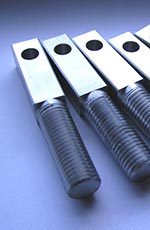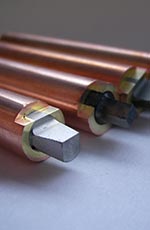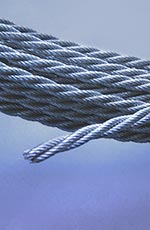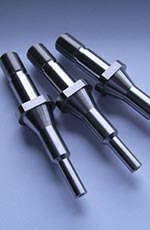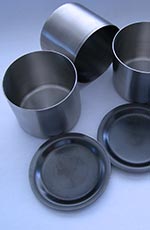Molybdenum (Mo, TZM, ML)
Molybdenum is a high-tensile, hard and silvery shining metal. The name originates from the Greek word Molybos for Lead, because of the frequently mix-up of Molybdenum-brightness (Mo-Disulfide) with Lead-brightness (Lead glance) or Graphite. It is mainly extracted from Molybdenite (Molybdenum Sulfite). The largest natural resources are located in the US, Chile, China and Canada. Approximately 80 % of the Molybdenum production is used for alloying of steel and casting. The balance is used for chemicals and Molybdenum metal respectively Molybdenum alloys.Significant Characteristics and Applications:
- high melting point, low vapor pressure
- good resistance and mechanical stability at high temperatures
- thermal shock resistant
- low thermal expansion
- application in reducing atmosphere or vacuum
- good chemical resistance in metal and glass melting
Pure Molybdenum is used for example for high temperature heating elements, shielding, filaments, evaporation crucibles, rocket propulsions, radiation shields, X-ray anodes, welding electrodes, thermodes, coatings for wear protection, components and melting electrodes for glass fabrication, sputtering targets and others.
Titanium-Zirconium-Molybdenum (TZM):
TZM is a micro-alloyed Molybdenum with Titanium-Zirconium-Carbides. By means of solid-solution and carbide-strengthening TZM features improved high temperature strength up to 1400°C and a higher recrystallization temperature, compared to pure Molybdenum.
Typical Applications of TZM:
Components for heat treatment equipment, supports, fixtures, carrier, hot runner nozzles, casting moulds, forging dies and others.
Molybdenum-Lanthanum (ML):
Through doping with Lanthanum-oxide and a suitable production process an elongated grain structure with fine disperse La2O3-particles (typ. 0.2-0.7 weight-% La2O3) occurs. This structure has a higher recrystallization temperature and a good creep resistance. Depending on the semi-finished product, lanthanated Molybdenum components can be used for temperatures up to 2000 °C.
Typical Applications of ML:
Heating elements, wires for lighting technology, sintering trays, hot-zone-components and others.
Material Types and Alloys:
- Mo 99,95 % (Type 360 – Unalloyed vacuum arc-cast)
- Mo 99,95 % (Type 361 – Unalloyed powder-metallurgical)
- Mo 99,96 % (Type 365 – Unalloyed vacuum arc-cast)
- TZM Titanium-Zirconium-Molybdenum (Type 363 Ti,Zr,C-alloyed vacuum arc-cast)
- TZM Titanium-Zirconium-Molybdenum (Type 364 Ti,Zr,C-alloyed powder-metallurgical)
- MoW30 (Type 366 vacuum arc-cast)
- ML Molybdenum-Lanthanum (Lanthanum oxide doped)
- MoRe47.5; MoRe44.5; MoRe41
ASTM Standard Specifications:
ASTM B387 (Molybdenum and Molybdenum Alloy Bar, Rod and Wire)
ASTM B386 (Molybdenum and Molybdenum Alloy Plate, Sheet, Strip, Foil)
ASTM F289 (Molybdenum Wire and Rod for Electronic Application)
ASTM F364 (Molybdenum Flattened Wire for Electron Tubes)
Range of Products:
Foils, strips, ribbons, sheets, plates, wires, rods, tubes, mesh, sputtering targets, electrodes, contacts, filaments, standard fasteners (screws, nuts, washers and others), crucibles, hot-zone-components , heating elements, sintering trays, supports, carriers, heat shielding, protective tubes for thermocouples, miscellaneous customer-specific components according to drawings.



